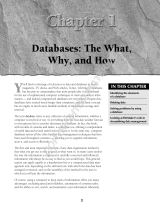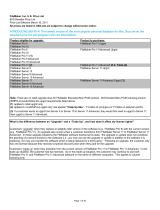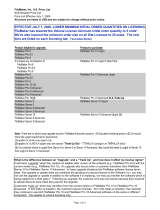Page is loading ...

Bento® 4
User’s Guide

© 2007-2012 FileMaker, Inc. All rights reserved.
FileMaker, Inc.
5201 Patrick Henry Drive
Santa Clara, California 95054
FileMaker and Bento are trademarks of FileMaker, Inc. registered in
the U.S. and other countries. The file folder logo and the Bento logo
are trademarks of FileMaker, Inc. All other trademarks are the
property of their respective owners.
FileMaker documentation is copyrighted. You are not authorized to
make additional copies or distribute this documentation without
written permission from FileMaker. You may use this documentation
solely with a valid licensed copy of FileMaker software.
All persons, companies, email addresses, and URLs listed in the
examples are purely fictitious and any resemblance to existing
persons, companies, email addresses, or URLs is purely coincidental.
Credits are listed in the Acknowledgements documents provided
with this software. Mention of third-party products and URLs is for
informational purposes only and constitutes neither an endorsement
nor a recommendation. FileMaker, Inc. assumes no responsibility with
regard to the performance of these products.
For more information, visit our website at http://www.filemaker.com.
Edition: 03

3
Contents
Preface 7Welcome to Bento
8 Managing Data in Libraries
14 About This Document
14 Resources for Learning More
Chapter 1 17 Overview of Bento
17 Home Dialog
18 Bento Window
Chapter 2 29 Using Libraries
29 About Libraries
30 Creating a Library Using the Bento Templates
32 Creating a New Blank Library
32 Changing the Icon for a Library
33 Sharing Your Bento Database
35 Grouping Libraries
35 Deleting Records from a Library
36 Deleting a Library
Chapter 3 37 Using the Address Book Library
37 About the Address Book Library
38 Displaying Data from the Address Book Application
39 Bento Address Book Fields That Update the Address Book Application
39 Troubleshooting Address Book Updates
40 Address Book Data and Backups
Chapter 4 41 Migrating the iCal, iPhoto, and Address Book Libraries
41 Migrating the iCal Libraries
42 Migrating the iPhoto Library
42 Migrating the Address Book Library

4 Contents
Chapter 5 43 Using Collections
43 About Collections
44 Creating Collections
45 Removing Records from a Collection
45 Deleting a Collection
45 About Smart Collections
45 Creating Smart Collections
46 Changing a Smart Collection
Chapter 6 47 Using Form View
47 About Forms
48 Creating Records in Form View
48 Editing Records in Form View
49 Duplicating Records in Form View
49 Deleting Records in Form View
50 Creating Forms
50 Deleting Forms
51 Showing and Hiding Forms
51 Duplicating Forms
51 Copying Forms
51 Renaming Forms
52 Locking and Unlocking Forms
52 Adding Fields to a Form
53 Tabbing Between Fields
53 Moving Fields and Objects on Forms
53 Resizing Fields and Objects
54 Removing Fields from a Form
54 Customizing Form Layouts
Chapter 7 59 Using Table View
59 About Table View
60 Selecting Records in Table View
60 Creating Records in Table View
61 Editing Records in Table View
62 Duplicating Records in Table View
62 Deleting Records in Table View
63 Sorting Records
63 Working with Fields and Columns in Table View
67 Summarizing Column Data

Contents 5
Chapter 8 69 Using Grid View
69 About Grid View
70 Viewing the Grid and a Form at the Same Time
70 Displaying Grid View Items
70 Setting Grid View Options
70 Changing the Display Size of Grid View Items
71 Working with Library Folders in Grid View
Chapter 9 73 Using Fields
73 About Fields
76 Creating Fields
84 Navigating to Related Records
84 Using the Fields Pane
86 Working with List Fields
92 Working with Related Data Fields
95 Working with Media Fields
97 Working with Encrypted Fields
100 Working with Location Fields
Chapter 10 103 Importing, Exporting, and Printing
103 About Comma-Separated and Tab-Separated Files
106 Importing Information into Bento
112 Exporting Information from Bento
117 Printing Information
Chapter 11 123 Backing Up and Restoring Information
124 About Bento Backup Files
125 Using the Back Up Reminder
125 Changing the Back Up Reminder
126 Creating a Backup File
126 Restoring from a Backup File
127 Using Time Machine with Bento
Chapter 12 129 Syncing
129 Syncing Information Between Your Mac and Devices
Appendix A 135 Keyboard Shortcuts
Appendix B 139 Reverting to a Previous Version of Bento
139 Reverting to a Previous Version from Bento 4
Index 143

6 Contents

7
Welcome to Bento
Bento® helps you organize your information, providing the
power of a database without complexity.
Bento is an easy-to-use database that manages contacts, tasks, and other information
that is important to you. Because Bento is a database, you can create data
relationships and view your data in more ways than you can in a spreadsheet.
Bento brings your important information together in one place to help you get
organized. You’ll be able to manage your contacts, coordinate events, track projects,
prioritize tasks, and more.

8Preface
Managing Data in Libraries
Bento comes with more than 30 library templates to help you create libraries easily.
You can create an Expenses library to track information about expenses, and an Event
Planning library to track information about your travel club events.

Preface 9
Bento provides a Projects library, so you’re ready to start managing projects for your
travel club.
Importing Data from Other Applications
How do you add your spreadsheet of expenses to Bento? Create a library by importing
data from another application, or import data into a library you’ve already created.
Save your spreadsheet as a comma-separated values (.csv), tab-separated values (.tab),
Numbers, or Excel file, and then import the file into Bento. Bento creates the fields
needed to hold your data and creates records for each row of data in the file.
Libraries Fields

10 Preface
Creating Collections
You have a team of people who are working with you on your next travel club event.
All of your team members are in the Bento Address Book library, but you’d like to
create a smaller group that includes only your team members, not everyone in the
Address Book library. You want to create a collection.
Creating a collection is as easy as creating a group in Address Book or a playlist in
iTunes. Open the Bento Address Book library in table view. Select the records for the
Importing
spreadsheet
data into a
Bento library.

Preface 11
team members and choose the New Collection from Selection menu item, or drag the
selected records to the Libraries pane.
Give the collection the name “Team Members” and Bento creates the Team Members
collection.
Drag the selected
records to the
Libraries pane.

12 Preface
Creating Relationships
Bento makes it easy to connect your libraries of information using related data fields.
For example, say you want to track expenses by team member. To create a related data
field, drag “Team Members” to the “Expenses” form.

Preface 13
You can also create a related data field that shows expenses for each team member.
Drag “Expenses” to the “Team Members” form.

14 Preface
About This Document
The following table tells you where to find information in this documentation.
Resources for Learning More
To get the most from Bento, consult the resources listed below.
User’s Guide
Bento User’s Guide is a PDF document that provides detailed information on using
Bento.
To open the User’s Guide:
Choose Help > Bento User’s Guide.
Onscreen Help
To access help from within Bento, choose Help > Bento Help. You can browse through
the table of contents to find a specific topic, or enter a question in the search field.
For information about See
The features of Bento Chapter 1, “Overview of Bento” on page 17
Using libraries to manage your information Chapter 2, “Using Libraries” on page 29
Using the Address Book library to display data from
the Mac OS Address Book application
Chapter 3, “Using the Address Book Library” on
page 37
Migrating existing iCal, iPhoto, and Address Book
libraries
Chapter 4, “Migrating the iCal, iPhoto, and
Address Book Libraries” on page 41
Creating a subset of records from a library Chapter 5, “Using Collections” on page 43
Viewing your data one record at a time, creating
forms, changing the appearance of forms, and
adding new fields to forms
Chapter 6, “Using Form View” on page 47
Viewing all the records in a library or collection in a
table
Chapter 7, “Using Table View” on page 59
Using media fields and library folders in grid view Chapter 8, “Using Grid View” on page 69
All the field types that Bento provides, and using
the Fields pane
Chapter 9, “Using Fields” on page 73
Sharing data by importing, exporting, and printing Chapter 10, “Importing, Exporting, and Printing”
on page 103
Creating a backup of your Bento data Chapter 11, “Backing Up and Restoring
Information” on page 123
Syncing information between Bento for Mac and
your device
Chapter 12, “Syncing” on page 129
Using keyboard shortcuts Appendix A, “Keyboard Shortcuts” on page 135
Reverting to a previous version of Bento Appendix B, “Reverting to a Previous Version of
Bento” on page 139

Preface 15
Tutorial
For a demonstration of what you can do with Bento, view the tutorials.
To access the tutorials:
Choose Help > Video Tutorial, and then follow the instructions.
Bento Forum
Visit the Bento forum to get technical support, tips, report problems, and share with
others how you use Bento.
To access the Bento forum:
Choose Help > Bento Forum.
Bento Template Exchange
Visit the Bento Template Exchange website to submit your own templates and
download templates created by other Bento users.
To access the Bento Template Exchange:
Choose Help > Bento Template Exchange.
Note You can also submit your templates directly from within Bento. See ”Submitting
Templates to the Bento Template Exchange” on page 114.
Bento for iPhone and Bento for iPad
Visit the Bento products web page to get information about the features of Bento for
iPhone and Bento for iPad.
To view information about Bento for iPhone and Bento for iPad:
Choose Help > Bento for iPhone, iPod touch and iPad.
Technical Support
To learn more about the support options that are available to Bento users, view the
service and support information.
To view the service and support information:
Choose Help > Service and Support.

16 Preface

1
17
Overview of Bento
This chapter provides an overview of Bento features.
This chapter is a description of what you see when you start using Bento. It introduces
the Home dialog and describes the sections of the Bento window, including the
Libraries pane, the Fields pane, and the records area where you can display your
information in table view, form view, grid view, or split view.
Home Dialog
When you first open Bento, you use the Home dialog to learn about Bento and to
create your first library.
Bento uses libraries to store
information. One way to start using
Bento is by creating a library.
When you’re done with the Home
dialog, click this button to start
using Bento.
If you decide that you don’t need the Home
dialog, deselect the “Show this dialog on startup” checkbox.
To see how easy it is to use,
take a video tour of Bento.

18 Chapter 1 Overview of Bento
Bento Window
The Bento window contains two main sections:
• The left side of the window contains the Libraries pane (which may display the
Devices section and the Shared section), and the Fields pane.
• The right side of the window displays the records in Bento. You can display
record data in table view, form view, grid view, or split view.
By default, both sections of the Bento window are displayed. To hide the Libraries
pane and Fields pane, choose View
> Hide Libraries & Fields Pane.
Libraries pane Records area
Fields pane

Chapter 1 Overview of Bento 19
Libraries Pane
The Libraries pane displays the libraries and collections that are in Bento.
• A library categorizes data by content. Bento provides several libraries by
default. The Projects library, which stores data about projects, is an example
library with sample data. You can create libraries to store other categories of
data. You can organize a group of libraries within a folder.
To add a library to the Libraries pane, click the New Library button. See ”Using
Libraries” on page 29.
• A collection is set of records from a library. A collection is similar to an Address
Book group or to a playlist in iTunes. A collection contains records from its
parent library. A record from the library can be in more than one collection.
For example, one person might be both a friend and a co-worker. If you had
one collection named “Friends” and another named “Co-workers” you could
add this person’s contact record to both collections in the Address Book
library.
To add a collection to the Libraries pane, click the New Collection button. See
”Using Collections” on page 43.
Tip If you want to change the size of the icons and text in the Libraries pane, choose
Bento > Preferences. For “Libraries Pane Text,” select Small or Large.
Address Book
Library
iCal Events
Library
Collection of
iCal Events
Collection of
records from
Projects
New Library
New Collection
iCal Tasks
Library
Projects Library

20 Chapter 1 Overview of Bento
Collections
Create a collection when you want a subset of the records from a library. There are two
kinds of collections:
• Collections are created by adding records from the library to a new collection.
Creating a collection is as easy as creating a playlist in iTunes. Select the
records in the library and use the New Collection from Selection menu item,
or drag the selected records to the Libraries pane.
• Smart Collections are created based on criteria you set up. Records that meet
the defined criteria appear in the Smart Collection. You use Advanced Find to
create a Smart Collection.
See ”Using Collections” on page 43.
Creating Libraries
Bento comes with more than 30 library templates that make it easy for you to create
new libraries of information. A template defines the fields of information used in each
record of a library, which you can change based on your needs. Select the library
template that most closely matches the category of data you want to store.
See ”Creating a Library Using the Bento Templates” on page 30.
/







